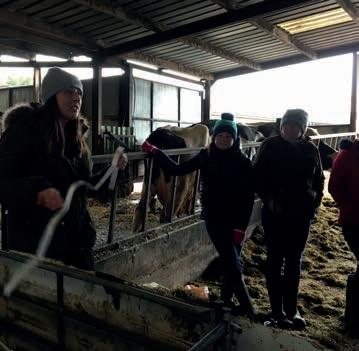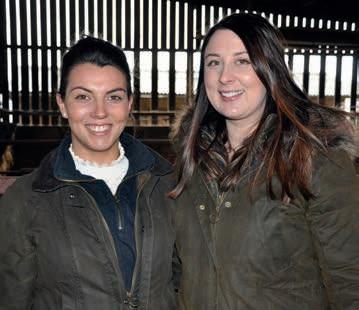
9 minute read
Workshops highlight the critical success factors for effective dairy calf rearing
Calf rearers across Wynnstay’s trading area now have an improved understanding of the important nutrition, health and hygiene practices so necessary for calves to hit optimum development and growth targets.
Thanks to a series of interactive workshops held earlier this year – organised by the Wynnstay Calf & Youngstock Team which involved a mix of classroom-based discussion and practical on-farm demonstrations – attending farmers left better equipped to improve their dairy calf rearing operations and realise the full performance potential of youngstock entering the adult milking herd.
“Whenever we get farmers together to talk about calf rearing, there is always an appetite for information exchange. Everybody participated enthusiastically and I’m sure they all went away eager to make at least one change at home,” says Jessica Yeomans from Wynnstay.
A member of the Wynnstay team opened each workshop by highlighting the crucial importance of ensuring newborn calves receive an adequate intake of good quality colostrum, either via a teat or by stomach tubing.
“Timing is everything. As soon as a dairy calf is born, whenever possible, try to harvest the colostrum quickly from the dam so that it can be fed to the newborn calf. This is where many farms struggle. Once you have obtained the colostrum, test its quality using a refractometer or colostrometer to ensure it is good enough to feed to the calf. If it’s not, draw on your stored colostrum that does make the quality grade,” says Jessica. The quantity of colostrum fed is also vital, and the aim should always be to make sure a newborn calf receives at least 10% of its birthweight in colostrum within the first few hours of life.
“Calves are born without the antibodies that are essential to prevent disease and colostrum is the sole source of these antibodies. Calves need a first feed of three litres within two hours of birth, followed by another similar sized feed within 6-12 hours of birth,” she says.
Asking your vet to blood test calves within a week of birth can also help to indicate whether they have received adequate colostrum.

Wynnstay calf specialist Jessica Yeomans explains how to use a simple weigh tape to measure calf growth rates. When it comes to managing the impact of disease, vet Mark Hickinson says that vaccination programmes, good hygiene and husbandry will often tip the health balance in a calf’s favour.
Follow the heifer roadmap
Volac representatives highlighted the company’s heifer roadmap, explaining the nutrition dairy calves require to be able to calve down at 24 months of age in a ‘fit not fat’ condition, as well as being primed to achieve their genetic milking performance potential.
“Heifers need to be growing at an average rate of 800g per day to produce their first calf at 24 months of age. Any growth setback due to inadequate nutrition or disease will impair optimum development efficiency and delay this recommended first calving age target,” says Volac’s global technical manager Ian Watson.
He stresses though that ‘not all growth is the same’, pointing out that with optimum nutrition calves will grow quickly and cost-effectively during early life, whilst also laying down important udder tissue during this period. “Milk replacer may look expensive on a per tonne basis, but the latest performance-formulated products based on high quality ingredients will payback handsomely if you feed your growing calves enough.”
Mr Watson explains that 750g per day of growth can only be achieved if pre-weaned calves receive at least 750g of milk powder per day, with ad-lib starter feed and fresh water always in front of them too.
“A 45kg calf needs 350g of milk powder just for maintenance (digestion, immune system function and keeping warm). Growth is only achieved when you feed a performanceformulated milk replacer above this level,” he says.
The good, the bad and the ugly
The Wynnstay Calf & Youngstock Team work very closely with farm vet practices and at the workshops local practitioners highlighted the key disease threats that calves face on a daily basis, as well as the poor husbandry and hygiene practices that can promote problems on any calf unit.
“We advise any farmer rearing calves to monitor growth rates and set a mortality target. Once you have done this be honest about your performance against your targets. Remember, if you don’t measure where you are, you can’t manage your business effectively,” says vet Mark Hickinson from Horizon Dairy Vets, who attended one of the events held in Shropshire.
“Asking your vet to carry out post-mortems and doing your own calf-side assessments – for example, using faecal sample diagnostic kits – can help you to identify the presence of some of the most common infectious scour organisms. You can then put in place an appropriate disease management plan, which may involve vaccination programmes, to mitigate the impact of any disease threats on your calf rearing operation.” He stresses that many of the organisms that cause debilitating calf disease problems – such as viruses, bacteria like salmonella and E. coli, and parasites – will thrive in dirty calf accommodation and on soiled feed and water feeding equipment.
“Maintaining a high hygiene status is essential if you want to rear healthy calves that grow well. Good hygiene practices along with a sound colostrum feeding protocol in early life – as well as rearing environment improvements and vaccination, where appropriate, to boost a calf’s immune system – will all help to tip the balance in the animal’s favour and make a calf less likely to succumb to any disease challenge,” he says.

Members of Wynnstay Calf & Youngstock Team, including Millie Hendy (left) and Jessica Yeomans (right), are keen to help local cattle farmers improve their calf rearing operations.
For further information contact the Wynnstay Calf & Youngstock Team www.wynnstay.co.uk/calf_and_youngstock_team
Jess Yeomans
Calf & Youngstock Specialist Shropshire, Cheshire, Staffordshire & N. Wales
m: 07990 584740 e: jess.charlton@wynnstay.co.uk @charltoncalf1
OPTIMAL COLOSTRUM QUALITY AND QUANTITY - IT COMES FROM THE MOTHER!
Colostrum is a concentrated source of nutrients, which includes fats, proteins, Immunoglobulins such as Immunoglobulin G (IgG), carbohydrates, vitamins and minerals. Ensuring that a newborn calf gets the correct amount of good quality colostrum as soon as possible after birth is paramount to produce a healthy calf.
Measuring colostrum quality
The use of a colostrometer or refractometer to measure the amount of immunoglobulins within the colostrum is essential to make sure that the calf receives enough passive immunity from its mother.
In some cases, very high yielding fresh cows producing a lot of milk produce less quality colostrum, however, if everything is done environmentally and nutritionally to prepare for this, it shouldn’t be the case. There are lots of things we can do to ensure high quality and high quantity of colostrum is produced from every cow all year round. ‘High Quality Colostrum’ can be defi ned as having at least 50 g/L IgG. This should ideally be farm specifi c in regard to the diseases that calves are likely to be exposed to. It should also be clean with a low bacterial count and free from any pathogens that can be transferred within it.
Colostrum production
The process of colostrum production in the udder begins several weeks before calving and stops abruptly when the calf is born. During this time, large amounts of IgG and other immune factors are selectively transferred from the bloodstream of the cow into colostrum. This starts approximately fi ve weeks prior to calving and is maximised in the last two weeks before calving (Maunsell, 2014), when a cow is in the close-up dry cow group. So, the way that the dry cow is managed can greatly impact the quality of colostrum produced. When thinking about the environmental impact the dry period has on colostrum, stress is one of the biggest factors. Stocking rate, feed availability, temperature, group changes, all have an impact on oxidative stress in the cow, which impacts immunity and possibly the quality of

colostrum produced.

Selenium and vitamin E are involved in immune function and may infl uence colostrum quality when they are defi cient. Cows fed a pre-partum diet defi cient in selenium and vitamin E produce less colostrum and lower total mass of colostral IgG than cows fed the same diet but supplemented with injections of vitamin E and selenium (Lacetera et al., 1996). It is important to supply adequate vitamins and minerals in the dry period, either through bolus, buckets, or tmr minerals, and consider if your cows get enough year round: speak to your Wynnstay Dairy Specialist regarding a review of your dry cow approach. Wynnstay’s Premier Dry Cow minerals contain optimum levels of vitamins and minerals, and contain IntelliBond ® Copper which have been shown to have less impact on vitamin E activity over time than traditional sulphates, so more being available to the cow in times of need (Figure 1).

(Figure 1). Vitamin E loss in feed following the addition of inorganic copper sulphate versus IntelliBond ® C in comparison to no additional copper.
Finally, another consideration for feeding the transition cow would be protein level. Inadequate metabolizable protein in the transition cow diet 3-4 weeks pre-calving may have an eff ect on the quantity of good colostrum produced. Make sure there are adequate levels, aiming for >1,200g MP in the close-up cow diet.

In conclusion, a few key points that should be taken into consideration:
1. Transfer of antibodies (especially IgG) from the blood of the cow into colostrum starts about fi ve weeks prior to calving: if colostrum is poor, look back at what happened in that cow’s dry period.
2. The older the cow, the better the colostrum – but there’s lots of individual variation! On average, fi rst-calf heifer colostrum is lower in volume and IgG concentration than that from older cows. However, many heifers produce very good quality colostrum. Don’t automatically discard heifer colostrum!
3. Colostrum should be tested and only discarded if it is: low quality, bloody, from sick cows, from cows with clinical mastitis, or from cows that are known to be infected with chronic diseases such as Johne’s disease or Mycoplasma.
4. Environmental stressors, such as heat stress, may reduce the quality of colostrum, especially in heifers.
5. Dry period length should be at least 3-4 weeks to maximize colostrum quality with adequate vitamins, minerals and protein level in the diet.
Bethany May
Dairy Specialist - North Wales
m: 07771 740857 e: bethany.may@wynnstay.co.uk





